Mexico-US trade totaled $671 billion in 2019, when the US exported goods and services worth $299 billion to Mexico and imported goods and services worth $372 billion from Mexico, that is, the US trade deficit with Mexico was $73 billion.
The US also has a trade deficit with Mexico in agricultural commodities. The US exported agricultural commodities to Mexico worth $18.5 billion a year between 2016 and 2018, and imported agricultural commodities from Mexico worth $24.5 billion a year, for an agricultural trade deficit of $6 billion a year.
Most US agricultural exports to Mexico are $5.6 billion worth pork and other animal products, corn and grains worth $5.2 billion, and soybeans and other oilseeds worth $3 billion. Agricultural imports from Mexico were dominated by fruits worth $6.5 billion led by avocados, vegetables worth $6.7 billion led by tomatoes, and beverages worth $3.7 billion led by beer.
Over the past decade, the value of US horticultural imports from Mexico tripled, from $5 billion a year to $15 billion a year. The value of avocado imports increased five-fold, and the value of fresh tomatoes almost doubled.
The value of Mexican avocado imports increased almost five-fold over the past decade
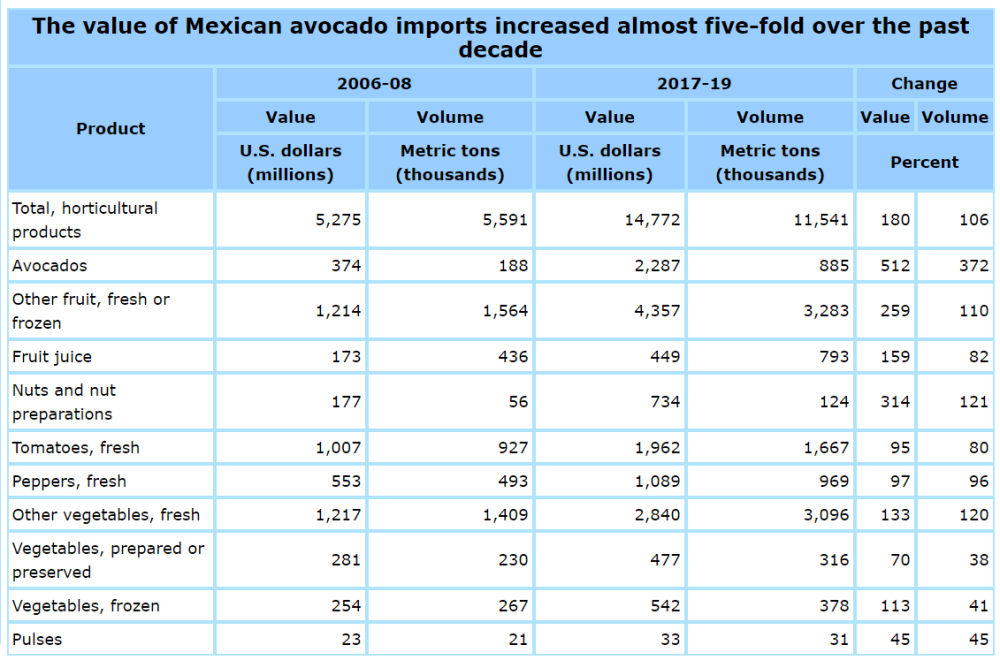
One reason Mexico is exporting more fruits and vegetables to the US is that production in Mexico increased. Mexico’s production of vegetables rose almost 60 percent over the past decade, led by 13 percent more tomatoes and nine percent more green peppers. Mexico’s production of fruit rose almost 30 percent.
Mexico exports over half of its production of three vegetables: cucumbers, asparagus, and broccoli, .The share of Mexican production of these vegetables that is exported is falling, meaning that Mexicans are consuming more of these vegetables. On the other hand, a rising share of the avocados produced in Mexico are exported, about 44 percent of total production in recent years. Similarly, Mexico exports less than half of the tomatoes it produces to the US.
The share of Mexican fruits and vegetables destined for the US varies by commodity
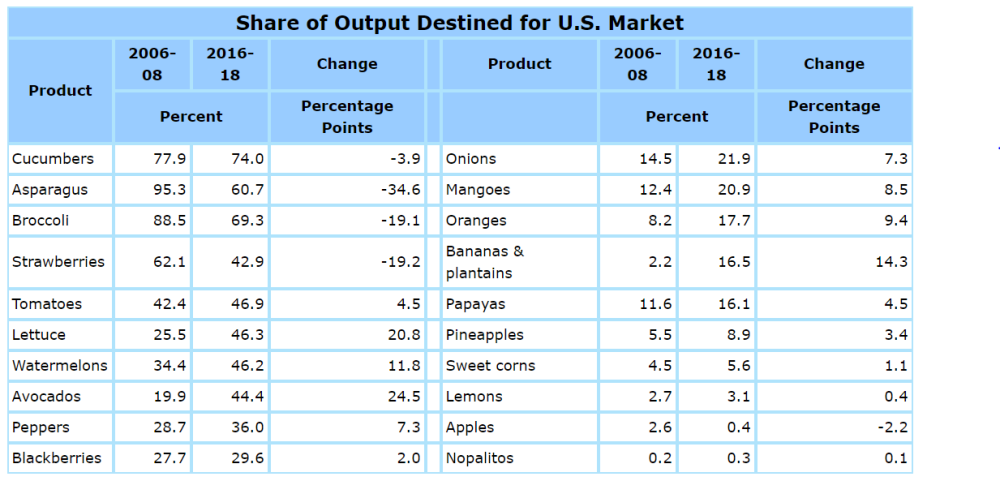
Mexico is a world leader in protected culture farming, using greenhouses and other structures to protect plants from weather and pests. Many of the tomatoes and other vegetables that Mexico exports to the US are grown in protected culture structures, where yields are much higher than in open fields and there are fewer insect and weed pressures.
Sinaloa produces almost 30 percent of Mexico’s average 3.5 million tons of tomatoes each year but, because Sinaloa tomatoes are grown both in open fields and under protected culture, average yields of 70 tons a hectare are less than in Puebla and San Luis Potosi, where a higher share of tomatoes are grown under protected culture.
Sinaloa produces 30 percent of Mexico’s tomatoes, but yields are highest in the protected culture of Puebla
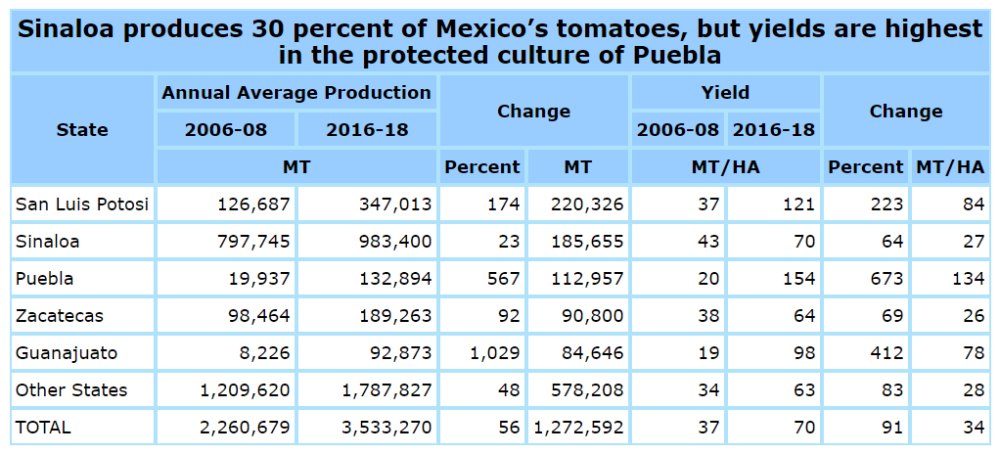
Most of the imported tomatoes grown in greenhouses are from Mexico, supplemented by greenhouse tomatoes from Canada.
Most US greenhouse tomato imports are from Mexico
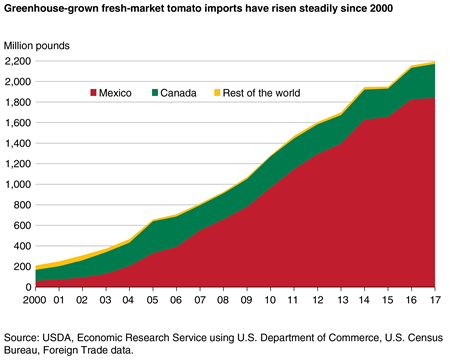
Michoacán produces three fourths of Mexico’s average two million metric tons of avocados each year, obtaining an average yield of 11 tons a hectare. Avocado production is expanding fastest in Jalisco, which produces a fifth of Mexico’s avocados and obtains slightly higher yields. Michoacán is the only state allowed to export fresh Hass avocados to the US.
Michoacán produces three fourths of Mexico’s avocados, but production in Jalisco is rising fast
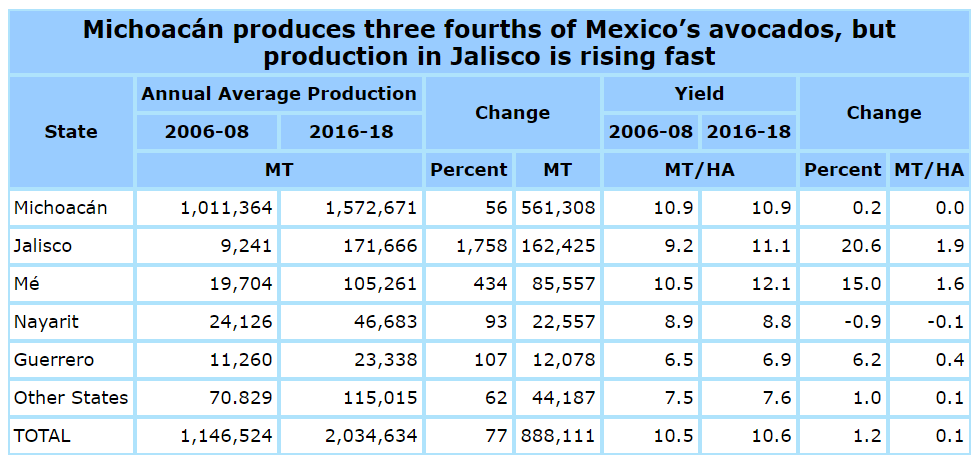
Production of labor-intensive commodities in Mexico for local consumption and exports is expected to increase. The use of protective culture farming reduces water use and raises yields and, combined with farm labor costs that are a tenth of US farm labor costs, makes Mexican produce competitive with US production.
Mexico’s major comparative advantage remains climate, the ability to produce fresh fruits and vegetables when US farmers except in Florida are not producing. Commodities such as avocados are produced year round, and protective culture is allowing Mexican farmers to extend their production and export seasons.
Author


Mexico Institute
The Mexico Institute seeks to improve understanding, communication, and cooperation between Mexico and the United States by promoting original research, encouraging public discussion, and proposing policy options for enhancing the bilateral relationship. A binational Advisory Board, chaired by Luis Téllez and Earl Anthony Wayne, oversees the work of the Mexico Institute. Read more

Explore More
Browse Insights & Analysis
Understanding Trade Promotion Authority (TPA): Implications for US Trade

The Innovative Landscape of African Sovereign Wealth Funds

